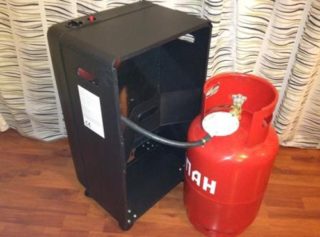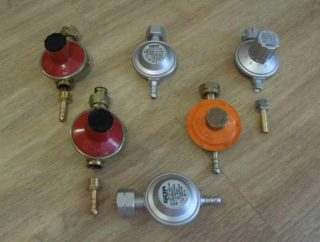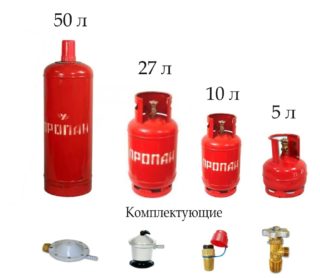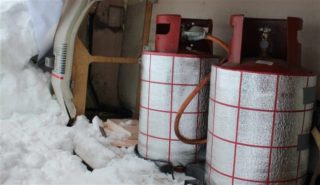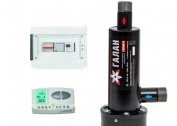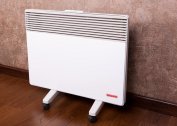A modern gas stove for the home is used to heat private buildings, cottages and summer cottages. There are many advantages to heating with gas tanks. This is a profitable option for those who do not plan to spend large sums on fuel. Ideal for home owners who do not have the ability to connect the heater to a single highway. It is worthwhile to study in advance the advantages and disadvantages of balloon heating, its connection diagram and safety precautions.
Pros and cons of heating gas cylinders
A gas oven for heating a house from a cylinder works with propane or butane. The main working component is liquefied during the production process and driven into the tank. The conversion of a gaseous substance into a liquid form is necessary because it will require containers of much larger volume for storage in the normal state. Gas liquefaction allows you to store it in cylinders in the maximum amount.
Ready-made cylinders are connected to a pressure reducing gear, due to which the gas returns to its initial state. Heat is generated during the combustion of gas inside the boiler.
The benefits of gas heating with cylinders include:
- full autonomy of the heating system;
- low consumption of raw materials and minimum fuel costs;
- stable pressure inside the pipes;
- lack of problems during operation and during installation.
This type of stove heating has its drawbacks. Cylinders cannot be left outside in the winter, at low temperatures they emit rapidly freezing condensate, which prevents a stable gas flow. In this case, the heating system will not receive enough fuel and will turn off automatically.
Connecting and storing the cylinders is necessary taking into account safety precautions, since in the event of a leak, gas poses a threat to life and health.
In a private house

The gas stove is suitable for heating a house with an area of up to 100 sq.m. With its help, you can create a convenient and efficient heating system for any building. For the house, it is worth choosing standard 50-liter cylinders with liquefied propane, butane or mixtures with combustible substances for the summer and winter periods.
For saunas and baths
A gas bath stove is able to heat a steam room to the desired level no worse than a standard wood counterpart. It is simple to operate, safe enough and does not require large expenses. If we are talking about a small bath or sauna, two or three convectors are installed in it, which operate on gas from cylinders. For a large bath with an area of up to 150-200 sq.m. It is advisable to create a separate gas boiler room and put the boiler.
The method of connecting gas cylinders to a heating boiler
Tanks are connected using a special gearbox that converts gas from a standard form to a gaseous one. In the process of connecting a stove or stove, you can use a single gear for all tanks or a separate gear for each. The first option will be less expensive. Several tanks are connected to one boiler at once to increase the time between refueling, for this purpose a ramp is used.
The wall thickness of the gas pipes cannot be less than 2 mm. In areas of passage through the walls of the pipe, foam after being placed in separate cases. The boiler is connected to the gas pipeline using a flexible connection.For the gearbox, you can use a sleeve made of rubber fabric or a dyurite hose.
Gas cylinders must be installed at a distance of at least 2 meters from the boiler in a separate room or in a special gas cabinet with insulation.
Component systems
In order to connect a bath or home gas stove, you need to choose a boiler with a reduced operating pressure and high efficiency. If necessary, connect the device to the gas pipeline from the highway additionally purchase a gas burner or chimney nozzles for it. The list of main components includes:
- a water or standard gas boiler with a burner;
- gas tanks with a volume of 50 l;
- gearboxes;
- ramp for connecting one or two cylinders;
- shutoff valves;
- gas pipeline complete with pipes and hoses.
The cost of gas using a gearbox should not exceed 1.8-2.0 cubic meters per hour. For such a system, a standard gas reducer with a flow rate of 0.8 cubic meters per hour is not suitable.
Gas filling
A gas stove for a building or a bath requires timely fueling of tanks. Tanks do not fill more than 85% of the total volume, since the gas can expand and break through the walls of the cylinders if they are filled in the cold and immediately brought into a warm room. Gas reserves can be replenished at gas stations or in autonomous points. Before you select and pump the substance, the container is placed on the scale in order to shut off the gas supply in time and prevent the increase in pressure.
Even if refueling is carried out according to the rules, the risk of overfilling remains. Small cylinders of 5 liters fill up to 2 kg, large 12 liters to 6 kg. This amount will be enough to warm the house or bath. The injection takes place at a high speed; if the critical level is exceeded, the excess must be pumped out immediately. It is better to refill the tanks in places where electronic scales with a shut-off device are present, which increase the level of safety.
Safety precautions
To prevent emergency situations for heating, do not use electric heaters, heating elements, heating coaxial cables and other elements. Fuel cylinders are stored only inside separate cabinets, in the upper parts of which openings for ventilation are made. They are recommended to be insulated from the inside on the sides and in the lower part with the help of foam. Cylinders should be filled according to the rules in order to avoid possible explosion of equipment at home. After assembly, the heating unit must be checked for possible leaks.
Features of work in the winter
It is better to store floor or wall containers with gas in insulated cabinets in the winter. At the same time, the cylinders themselves cannot be heated or insulated, they can be placed inside individual structures with minimal heating. You can not store empty cylinders, full can be put at least 10 meters from the nearest living quarters. Before carrying out the calculations, it must be taken into account that in winter the energy consumption costs increase significantly, and in the summer they decrease.
In autumn, it is recommended that you first make a supply of fuel and assemble a special rack for storing containers outside the house. The rack is insulated and placed cylinders in a horizontal position.
You can rearrange cylinders vertically only after connecting to a single system. This requirement must be observed, because the gas from the inside presses on the walls and acts on the upper part. In horizontal position, the risk of leakage will be minimized.
